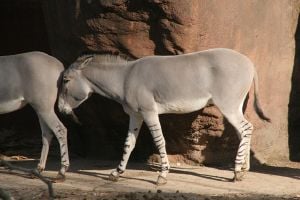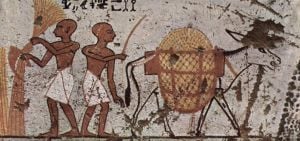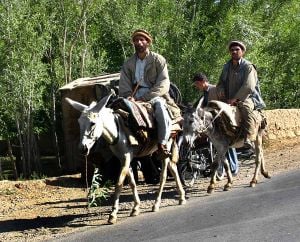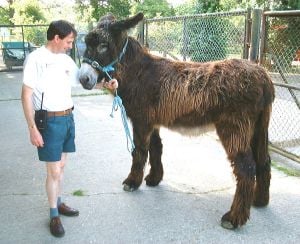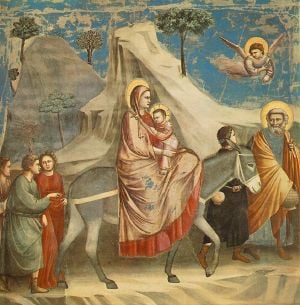Difference between revisions of "Donkey" - New World Encyclopedia
| Line 36: | Line 36: | ||
Wild asses were hunted by humans for their meat and skins. It is thought that hunters sometimes found orphaned colts and took them to their homes to keep as pets. Asses adapted well to conditions in human settlements and were able to breed in captivity. Over time this gave rise to the domesticated donkey. The first evidence of the donkey comes from [[Egypt]] around 4,000 B.C.E. (Clutton-Brock 1999). | Wild asses were hunted by humans for their meat and skins. It is thought that hunters sometimes found orphaned colts and took them to their homes to keep as pets. Asses adapted well to conditions in human settlements and were able to breed in captivity. Over time this gave rise to the domesticated donkey. The first evidence of the donkey comes from [[Egypt]] around 4,000 B.C.E. (Clutton-Brock 1999). | ||
| − | The donkey became an important pack animal for people living in the Egyptian and Nubian regions as they can easily carry 20 to 30 percent of their own body weight and can also be used | + | The donkey became an important pack animal for people living in the Egyptian and Nubian regions as they can easily carry 20 to 30 percent of their own body weight and can also be used to pull a plow and as a dairy animal. By 1800 B.C.E., the donkey had reached the [[Middle East]] where the trading city of [[Damascus]] was referred to as the “City of Asses” in [[Cuneiform script|cuneiform]] texts. [[Syria]] produced at least three breeds of donkeys, including a saddle breed with a graceful, easy gait. These were favored by women. |
Soon after the domesticated horse was introduced to the Middle East, around 1500 B.C.E., donkeys and horses began to be bred together giving birth to mules. (A mule is the offspring of a male donkey and a female horse. The mating of a male horse and a female donkey produces a hinny.) As a work animal the mule is superior to both the donkey and the horse. Domestic animal expert Juliet Clutton-Brook writes (Clutton-Brock 1999): | Soon after the domesticated horse was introduced to the Middle East, around 1500 B.C.E., donkeys and horses began to be bred together giving birth to mules. (A mule is the offspring of a male donkey and a female horse. The mating of a male horse and a female donkey produces a hinny.) As a work animal the mule is superior to both the donkey and the horse. Domestic animal expert Juliet Clutton-Brook writes (Clutton-Brock 1999): | ||
| Line 86: | Line 86: | ||
[[Image:Giotto - Scrovegni - -20- - Flight into Egypt.jpg|thumb|Mary and Jesus riding a donkey by Giotto]] | [[Image:Giotto - Scrovegni - -20- - Flight into Egypt.jpg|thumb|Mary and Jesus riding a donkey by Giotto]] | ||
==Cultural references== | ==Cultural references== | ||
| − | |||
The long history of human use of donkeys means that there is a rich store of cultural references to them. | The long history of human use of donkeys means that there is a rich store of cultural references to them. | ||
Revision as of 03:02, 3 December 2006
| Donkey Conservation status: Domesticated | ||||||||||||||
|---|---|---|---|---|---|---|---|---|---|---|---|---|---|---|
| Donkey | ||||||||||||||
| Scientific classification | ||||||||||||||
| ||||||||||||||
| Binomial name | ||||||||||||||
| Equus asinus Linnaeus, 1758 |
The donkey or ass, Equus asinus, is a member of the horse family, Equidae, of the order Perissodactyla, odd-toed ungulates (hoofed mammals). The word donkey refers to the domesticated E. asinus, while its wild ancestor, also E. asinus, is called the wild ass.
Donkeys were first domesticated around 4000 B.C.E. and have spread around the world in the company of humans. They continue to fill important roles in many places today and are increasing in numbers and popularity.
The wild ass
Wild asses are native to North Africa and the Arabian Peninsula. They are well suited to life in a desert or semi-desert environment. They stand about 125 to 145 cm (4.2 to 5.5 ft) tall at the shoulder and weigh about 275 kg (605 lb). They have tough digestive systems which can break down desert vegetation and extract moisture from food efficiently. They can also go without water for a fairly long time. Their large ears give them an excellent sense of hearing and help cool their blood.
Because of the sparse vegetation in their environment wild asses live separated from each other (except for mothers and young), unlike the tightly grouped herds of wild horses. They have very loud voices, which can be heard for over 3 km (2 miles) which helps them to keep in contact with other asses over the wide spaces of the desert.
Wild asses can run swiftly, almost as fast as a horse. But, unlike most hoofed mammals, their tendency is to not to flee right away from a potentially dangerous situation, but to investigate first before deciding what to do. When they need to they can defend themselves with kicks from both their front and hind legs.
The wild ass today is found only in small areas in northeast Africa and is an endangered species, mainly because of hunting. At one time there were at least four subspecies of wild ass. Today only the Somali wild ass (E. asinius somalicus) survives. It is thought that the donkey is derived from the Nubian wild ass (E. asinus africanus) which became extinct in the Twentieth Century (Huffman 2006).
Closely related to the wild ass are the other members of the horse family (all of which are also endangered in the wild): The horse (Equus caballus), the onager (E. hemionus), the kiang (E. kiang), Grevy's zebra (E. greyi), Burcell's zebra (E. burchelli), and the mountain zebra (E. zebra). All of these species can interbreed with each other, although the offspring are almost always sterile. Another horse family species, the quagga (E. quagga), became extinct in 1883 (Nowak 1986).
History
Wild asses were hunted by humans for their meat and skins. It is thought that hunters sometimes found orphaned colts and took them to their homes to keep as pets. Asses adapted well to conditions in human settlements and were able to breed in captivity. Over time this gave rise to the domesticated donkey. The first evidence of the donkey comes from Egypt around 4,000 B.C.E. (Clutton-Brock 1999).
The donkey became an important pack animal for people living in the Egyptian and Nubian regions as they can easily carry 20 to 30 percent of their own body weight and can also be used to pull a plow and as a dairy animal. By 1800 B.C.E., the donkey had reached the Middle East where the trading city of Damascus was referred to as the “City of Asses” in cuneiform texts. Syria produced at least three breeds of donkeys, including a saddle breed with a graceful, easy gait. These were favored by women.
Soon after the domesticated horse was introduced to the Middle East, around 1500 B.C.E., donkeys and horses began to be bred together giving birth to mules. (A mule is the offspring of a male donkey and a female horse. The mating of a male horse and a female donkey produces a hinny.) As a work animal the mule is superior to both the donkey and the horse. Domestic animal expert Juliet Clutton-Brook writes (Clutton-Brock 1999):
- "The mule is a perfect example of hybrid vigour - as a beast of burden it has more stamina and endurance, can carry heavier loads, and is more sure-footed than either the ass or the horse."
Donkeys, along with horses and mules, gradually spread around the world. In 1495, the donkey was introduced to the New World by Columbus. Different breeds of donkeys were developed, including the Poitou of France and the Mammoth Jack Stock of the United States (said to be originally developed by George Washington) which were both bred to sire mules. Both are larger than average donkeys, around 1.3 to 1.5 meters (51 to 59 inches) tall at the shoulders. In the Twentieth Century miniature donkeys, only 0.9 meters (36 inches) tall or less became popular as pets (OSU 2006).
Economic use
Donkeys have a reputation for stubbornness, but this is due to some handlers' misinterpretation of their highly-developed sense of self preservation. It is difficult to force or frighten a donkey into doing something it sees as contrary to its own best interest, as opposed to horses who are much more willing to, for example, go along a path with unsafe footing.
Although formal studies of their behaviour and cognition are rather limited, donkeys appear to be quite intelligent, cautious, friendly, playful, and eager to learn. They are many times fielded with horses due to a perceived calming effect on nervous horses. If a donkey is introduced to a mare and foal, the foal will often turn to the donkey for support after it has left its mother.[1]
Once a person has earned their confidence they can be willing and companionable partners and very dependable in work and recreation. For this reason, they are now commonly kept as pets in countries where their use as beasts of burden has disappeared. They are also popular for giving rides to children in holiday resorts or other leisure contexts.
In prosperous countries, the welfare of donkeys both at home and abroad has recently become a concern, and a number of sanctuaries for retired donkeys have been set up.
Types of donkeys
Domestic donkey breeds
An incomplete list of domestic donkey breeds includes the:
- Mammoth Donkey
- Poitou Donkey
- American Spotted Donkey
The Poitou Donkey breed was developed in France for the sole purpose of producing mules. It is a large donkey breed with a very long shaggy coat and no dorsal stripe.
Burro
The Spanish brought burros to North America beginning in the late fifteenth century. These burros were used as pack animals, but also for riding and pulling carts. These pack animals were prized for their hardiness in arid country and became the beast of burden of choice by early prospectors in the Southwest United States. The wild burros on the western rangelands descend from burros that escaped, were abandoned, or were freed.
Wild burros in the United States are protected by Public Law 92-195, The Wild Free-Roaming Horses and Burros Act of 1971. These animals, considered to be a living legacy, have lately been at risk due to drought. The Bureau of Land Management conducts round-ups of endangered herds, and holds public auctions. More information can be obtained from U.S. Department of the Interior, Bureau of Land Management.
Wild burros make good pets when treated well and cared for properly. They are clever and curious. When trust has been established, they appreciate, and even seek, attention and grooming.
Donkey hybrids
A male donkey (jack) can be crossed with a female horse to produce a mule. A male horse can be crossed with a female donkey (jennet or jenny) to produce a hinny. This is North American nomenclature; in the United Kingdom, the word hinny is not used. A female donkey in the U.K. is called a mare, or jenny and the word jennet is more commonly applied to the offspring of a female donkey and a male horse, regardless of whether the foal is female or male.
Horse-donkey hybrids are almost always sterile because horses have 64 chromosomes whereas donkeys have 62, producing offspring with 63 chromosomes. Due to different mating behavior, jacks are often more willing to cover mares than stallions are to breed jennets. Mules are much more common than hinnies. This is believed to be caused by two factors, the first being proven in cat hybrids, that when the chromosome count of the male is the higher, fertility rates drop (as in the case of stallion x jennet). The lower progesterone production of the jennet may also lead to early embryonic loss. Although it is commonly believed that mules are more easily handled and also physically stronger than hinnies, making them more desirable for breeders to produce, it is simply that mules are more common in total number.
The offspring of a zebra-donkey cross is called a zonkey, zebroid, zebrass, or zedonk,[2]; Zebra mule is an outdated term. The foregoing terms generally refer to hybrids produced by breeding a male zebra to a female donkey. Zebra hinny, zebret and zebrinny all refer to the cross of a female zebra with a male donkey. Zebrinnies are rarer than zedonkies because female zebras in captivity are most valuable when used to produce full-blooded zebras. [3] There are not enough female zebras breeding in captivity to spare them for hybridizing; there is no such limitation on the number of female donkeys breeding.
For at least the past century, a few donkeys and burros in Mexico have been painted with white stripes to amuse tourists. These are not hybrids.
Cultural references
The long history of human use of donkeys means that there is a rich store of cultural references to them.
Religion and myth
- The ass may have been the symbol of the Egyptian god, Seth
- Several were buried in Hor-Aha's tomb [4]
- The ass was a symbol of the Greek god Dionysus, particularly in relationship to his companion, Silenus.
- Greek mythology includes the story of King Midas who judged against Apollo in favor of Pan during a musical contest, and had his ears changed to those of a donkey as punishment.
- There are numerous references to donkeys (chamor) in the Hebrew Bible, including Numbers 22:22-41 where the "Lord opened the mouth of the donkey" (vs. 28) and it speaks to Balaam and Judges 15:13-17 where the hero Samson slays Philistines with the jawbone of an ass. Additional references can be found in Deuteronomy 22:10, Job 11:12, Proverbs 26:3 and elsewhere.
- In the Gospels, Jesus rides a donkey into Jerusalem (Mark 11:1 in which colt refers to a donkey colt). Traditionally, Mary is portrayed as riding a donkey while pregnant. These beliefs have given rise to legends explaining the origin of the cross on a donkey's shoulders [citation needed].
For the Greeks, the donkey was associated with the Syrian God of wine, Dionysius. The Romans also valued the donkey and would use it as a sacrificial animal
The donkey makes a number of appearances in the Bible. In fact, the most common Greek word for ass, hamor, appears roughly 100 times in the Biblical text. In the Old Testament, God chose to speak through a donkey to show Balaam the folly of his ways. In the New Testament, Christ rode into Jerusalem on the back of a donkey’s colt. Legend has it that the cross on the donkey’s shoulders comes from the shadow of Christ’s crucifixion, placing the donkey at the foot of the cross. It was once believed that hair cut from this cross and hung from a child’s neck in a bag would prevent fits and convulsions.
ReferencesISBN links support NWE through referral fees
- Blench, R. 2000. "The history and spread of donkeys in Africa ". Animal Traction Network for Eastern and Southern Africa (ATNESA)
- Clutton-Brook, J. 1999. A Natural History of Domesticated Mammals. Cambridge, UK: Cambridge University Press. ISBN 0521634954
- The Donkey Sanctuary. 2006. Website. [1]
- Huffman, B. 2006. The Ultimate Ungulate Page. "Equus asinus" [2]
- Huggins, B. 2002. "Equus asinus" (On-line), Animal Diversity Web. Accessed November 29, 2006 at [3]
- International Museum of the Horse (IMH). 1998. "Donkey" [4]
- Invasive Species Specialist Group (ISSG). 2006. "Global Invasive Species Database: Equus asinus" [5]
- Nowak, R.M. and Paradiso, J.L. 1983. Walker's Mammals of the World. Baltimore, Maryland, USA : The Johns Hopkins University Press ISBN 0801825253
- Oklahoma State University (OSU). 2006. Breeds of Livestock. [6]
- Starkey, P. and M. 1997 "Regional and world trends in donkey populations". Animal Traction Network for Eastern and Southern Africa (ATNESA) [7]
- Voelker, W. 1986. The Natural History of Living Mammals. Medford, New Jersey, USA : Plexus Publishing, Inc. ISBN 0937548081
Credits
New World Encyclopedia writers and editors rewrote and completed the Wikipedia article in accordance with New World Encyclopedia standards. This article abides by terms of the Creative Commons CC-by-sa 3.0 License (CC-by-sa), which may be used and disseminated with proper attribution. Credit is due under the terms of this license that can reference both the New World Encyclopedia contributors and the selfless volunteer contributors of the Wikimedia Foundation. To cite this article click here for a list of acceptable citing formats.The history of earlier contributions by wikipedians is accessible to researchers here:
The history of this article since it was imported to New World Encyclopedia:
Note: Some restrictions may apply to use of individual images which are separately licensed.
- ↑ Donkeys
- ↑ American Donkey and Mule Society: Zebra Hybrids
- ↑ All About Zebra Hybrids
- ↑ Cite error: Invalid
<ref>tag; no text was provided for refs namedegypt
